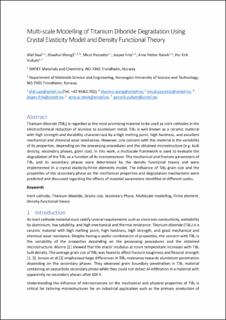| dc.contributor.author | Saai, Afaf | |
| dc.contributor.author | Wang, Zhaohui | |
| dc.contributor.author | Pezzotta, Micol | |
| dc.contributor.author | Friis, Jesper | |
| dc.contributor.author | Ratvik, Arne Petter | |
| dc.contributor.author | Vullum, Per Erik | |
| dc.date.accessioned | 2020-12-02T08:59:59Z | |
| dc.date.available | 2020-12-02T08:59:59Z | |
| dc.date.created | 2018-05-28T17:25:27Z | |
| dc.date.issued | 2018 | |
| dc.identifier.citation | Light Metals. 2018, 2018 1329-1336. | en_US |
| dc.identifier.issn | 0147-0809 | |
| dc.identifier.uri | https://hdl.handle.net/11250/2711343 | |
| dc.description.abstract | Titanium diboride (TiB2) is regarded as the most promising material to be used as inert cathodes in the electrochemical reduction of alumina to aluminium metal. TiB2 is well known as a ceramic material with high strength and durability characterized by a high melting point, high hardness, and excellent mechanical and chemical wear resistances. However, one concern with this material is the variability of its properties, depending on the processing procedures and the obtained microstructure (e.g. bulk density, secondary phases, grain size). In this work, a multiscale framework is used to evaluate the degradation of the TiB2 as a function of its microstructure. The mechanical and fracture parameters of TiB2 and its secondary phases were determined by the density functional theory and were implemented in a crystal elasticity-finite elements model. The influence of TiB2 grain size and the properties of the secondary phase on the mechanical properties and degradation mechanisms were predicted and discussed regarding the effects of material parameters identified at different scales. | en_US |
| dc.language.iso | eng | en_US |
| dc.publisher | Springer | en_US |
| dc.relation.ispartofseries | The Minerals, Metals & Materials Series;2367-1181 | |
| dc.subject | Density functional theory | en_US |
| dc.subject | Finite element | en_US |
| dc.subject | Multiscale modelling | en_US |
| dc.subject | Secondary phase | en_US |
| dc.subject | Grains size | en_US |
| dc.subject | Titanium diboride | en_US |
| dc.subject | Inert cathode | en_US |
| dc.title | Multi-scale Modelling of Titanium Diboride Degradation Using Crystal Elasticity Model and Density Functional Theory | en_US |
| dc.title.alternative | Multi-scale Modelling of Titanium Diboride Degradation Using Crystal Elasticity Model and Density Functional Theory | en_US |
| dc.type | Peer reviewed | en_US |
| dc.type | Journal article | en_US |
| dc.description.version | acceptedVersion | en_US |
| dc.rights.holder | © The Minerals, Metals & Materials Society 2018. This is the authors accepted and peer-reviewed manuscript. The final version is available at SpringerLink: https://link.springer.com/chapter/10.1007%2F978-3-319-72284-9_174 | en_US |
| dc.source.pagenumber | 1329-1336 | en_US |
| dc.source.volume | 2018 | en_US |
| dc.source.journal | Light Metals | en_US |
| dc.identifier.doi | 10.1007/978-3-319-72284-9 | |
| dc.identifier.cristin | 1587238 | |
| cristin.unitcode | 7401,80,6,6 | |
| cristin.unitcode | 7401,80,0,0 | |
| cristin.unitname | Material- og konstruksjonsmekanikk | |
| cristin.unitname | SINTEF Materialer og kjemi | |
| cristin.ispublished | true | |
| cristin.fulltext | original | |
| cristin.qualitycode | 1 | |
